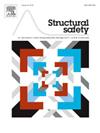An effective active learning strategy for reliability-based design optimization under multiple simulation models
Abstract
This paper proposes an effective active learning strategy for reliability-based design optimization (RBDO) problems in which the constraint functions are acquired from multiple simulation models. To achieve this goal, a new active learning function (ALF) is derived by estimating the increased reliability of active constraint functions after adding one point to the train points of constraint functions in each simulation model. The proposed ALF distinguishes possibly active constraint functions that seem active near the current optimum and considers how the constraint functions are active. In the proposed RBDO method, a Kriging model is iteratively updated by adding the best point to the train points of constraint functions included in the crucial simulation model until the optimum converges and the Kriging model is sufficiently accurate. The best point and the crucial simulation model are obtained by comparing the proposed ALF. The ALF is further modified to apply to problems where the cost of each simulation model is different. To verify the effectiveness of the proposed method, two numerical and one engineering examples are analyzed. The results show that the proposed method efficiently and accurately obtains the RBDO optimum involving multiple simulation models, regardless of simulation cost.

 求助内容:
求助内容: 应助结果提醒方式:
应助结果提醒方式:


